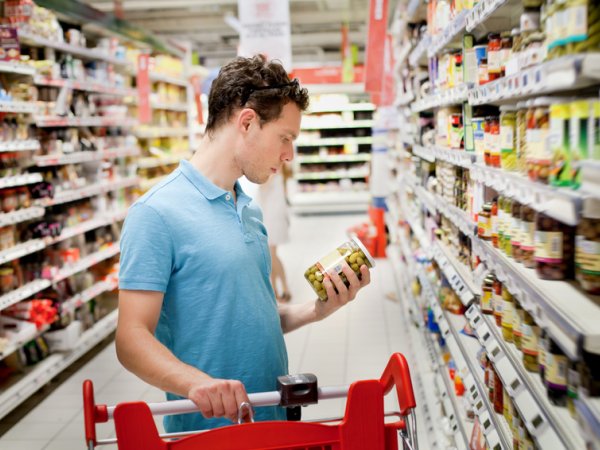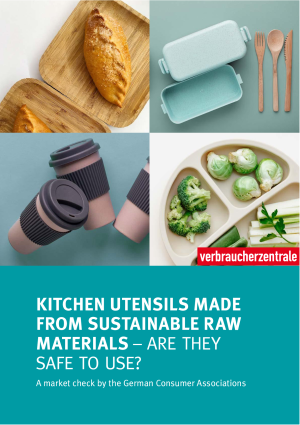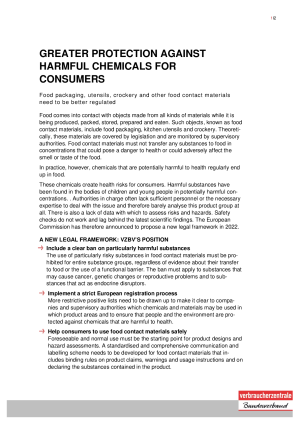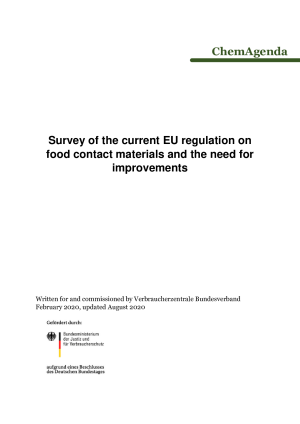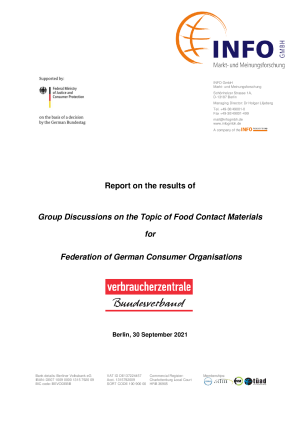Plasticisers in drinking bottles, mineral oils in chocolate, formaldehyde in coffee cups – when it comes to food, consumers are exposed to countless harmful substances and potentially toxic chemicals. During its manufacturing, packaging, storage, preparation and consumption, food comes into contact with various materials, which are called food contact materials.
In theory, components and ingredients of these materials must not migrate into the food in amounts which might endanger human health or which might affect the smell or taste of a food product. In practice, however, unappetising and harmful residues are regularly found in food.
More effective legislation and better food controls are therefore urgently needed to reduce the contamination of food products with harmful substances and to better protect consumers’ health.
The European Commission will present a new legislative framework in 2023. It has to make sure that consumers can rely on the safety of food packaging and dishes.
vzbv demands
- clear bans on most harmful substances
- a strict European approval scheme for all food contact materials
- support to consumers so that they can use food contact materials safely
- to keep harmful products away from the market
- to strengthen market surveillance and enforcement of rules
Food contact materials include all materials and articles intended to come into contact with food - for example food packaging and kitchen utensils. These are a variety of products made from different materials such as plastic, paper and cardboard, aluminium or a mixture of materials.
Materials and articles intended to come into contact with food must be marked with the words ‘for food contact’, or a specific indication ("dishwasher safe") or the wine glass and fork symbol.

The information needs to be displayed on the materials and articles, on their packaging or on external labels.
Articles in which food is already packed and which consumers buy together with the food, or to articles which are obviously intended for use in contact with food (such as dishes and cutlery) do not need to show this information.
According to the EU Framework Regulation on Food Contact Materials (EC) No 1935/2004, food contact materials must not endanger human health, bring about an unacceptable change in the composition of the food or affect the smell or taste of the food. However, this legal provision is not sufficient to protect the health of consumers.
The regulation defines 17 groups of materials - from cork and glass to plastics and textiles - for which the European Commission or Member States can adopt specific rules. So far, EU rules exist only for the group of plastics, regenerated cellulose (such as cellophane foil), epoxy derivatives (such as for coatings inside cans) and ceramics. Uniform EU-wide rules are lacking, for example, for paper, adhesives or coatings. Some Member States have adopted national rules to close this gap. This has developed into a patchwork of rules and recommendations that inadequately protects human health and poses a challenge to market surveillance authorities.
A declaration of compliance is required for materials for which the European Commission has adopted specific legislation. In this declaration, the manufacturer demonstrates compliance with the rules.
The European Commission's Regulation (EC) No 2023/2006 also lays down rules for "good manufacturing practice" as well as rules for quality assurance and quality control. These rules are binding for all manufacturers throughout the EU.
At national level, food contact materials are regulated by the German Food, Commodities and Feed Code (Lebensmittel-, Bedarfsgegenstände- und Futtermittelgesetzbuch; LFGB). The checks are performed by the authorities of the federal states responsible for food safety. However, in many cases these authorities are poorly staffed and can hardly or only insufficiently check food contact materials.
The EU Member States have tools available to identify products that are dangerous for human health through import controls. This type of import control is carried out in cooperation with customs, food safety authorities and the competent regional authorities.
The EU rapid alert system for food and feed regularly identifies unsafe products, such as food contact materials. These products often have their origin outside the European Union, but also in the European Union and the national market.
Food packaging has been the blind spot of European legislation in recent decades. While the EU chemicals regulation REACH stipulates that chemicals may only be used in articles of daily use under certain conditions, chemicals in food contact materials are largely unregulated. The EU Framework Regulation (EC) No 1935/2004 has not been modernised since 1976. Some scientists consider chemicals that transfer from food packaging into food to be the largest and most poorly controlled source of food contamination.
The Regulation of plastics also does not adequately protect consumers. Once approved for use in food contact materials, chemicals are not routinely evaluated when potential health hazards come to light. For example, a 2014 evaluation showed that 21 chemicals approved for use in plastic food contact materials were listed as substances of very high concern in the REACH regulation on chemical safety.
Consumers therefore urgently need better protection from harmful substances in food contact materials.
Food contact materials can be harmful to health if substances transfer from these materials into the food. The extent to which a substance transfers into the food depends on various factors such as the storage period of the food, the storage temperature, the fat and acid content of the food, the size of the contact surface between the food and the material, and the exposure of the food in the packaging to ultraviolet light. Depending on the material, the kinds of substances that are transferred into the food vary.
Plasticisers are used in plastics to make them soft, pliable or stretchable. Some fresh meat counters in stores use PVC films containing phthalates to package fresh meat. Plasticisers are also often found in the sealing ring of the screw-on lid of jars. Plasticisers are harmful to health. For example, very high concentrations affect testosterone levels in foetuses and thus the reproductive system. In the German Environmental Health Study, the Federal Environment Agency detected plasticisers in the urine of almost all children and young people studied.
Bisphenol A (BPA) is used for the production of food contact materials made of polycarbonate plastics and for coatings. BPA is found, for example, in drinking bottles, household appliances with plastic containers (e.g. kettles), and inner coatings of food and beverage cans. BPA is criticized primarily because of its hormone-like effects in the human body. New-borns and infants are considered to be a special risk group due to their low body weight.
Per- and polyfluorinated alkyl substances (PFAS) are used in non-stick pans, foils or in coatings of kitchen items such as plates, cups or storage boxes. In addition, certain PFAS are used in the manufacture of paper packaging intended to come into contact with hot liquid or fatty foods (including fast food packaging). PFAS can accumulate in the human body because they break down very slowly. According to the European Food Safety Authority (EFSA), there are insufficient studies that assess health effects from PFAS. However, EFSA assumes links between specific PFAS and reduced vaccination efficacy, lower birth weight, increased cholesterol levels and infections such as intestinal inflammation. However, many of the 4,700 substances are still poorly studied.
The German coalition agreement states that "We will [...] conduct research into substances that are hazardous to health, such as endocrine disruptors, multiple exposures and food contact materials. [...] We will better protect our companies and consumers from imports that do not meet EU standards by working with the federal states to strengthen enforcement and facilitate product recalls."
From the vzbv's point of view, these plans do not go far enough. At EU level, the German Government must advocate for a comprehensive reform of the Framework Regulation (EC) No 1935/2004.
The European Commission announced in the Farm to Fork Strategy that it would review the provisions in the area of food contact materials. The European Commission’s stipulated aim is to reduce the use of hazardous chemicals.
The European Commission announced to publish a legislative proposal. It is not clear when this will happen.

